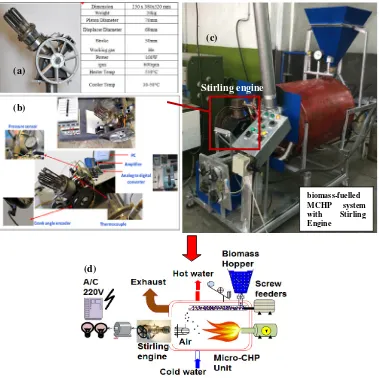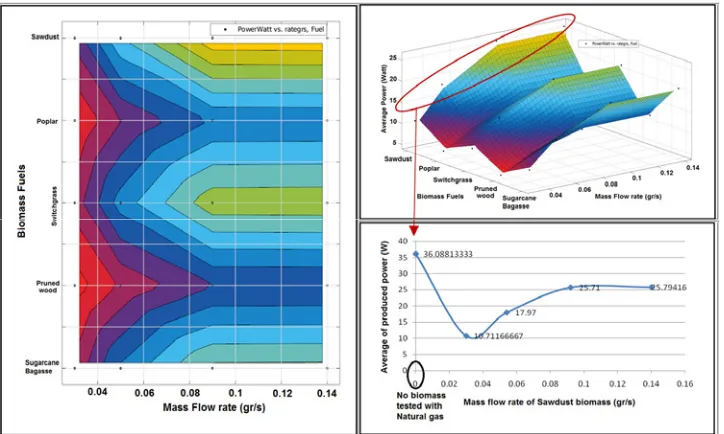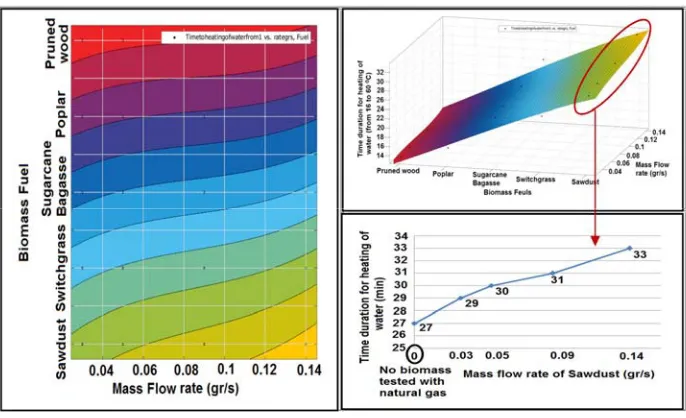1876-6102 © 2015 The Authors. Published by Elsevier Ltd. This is an open access article under the CC BY-NC-ND license (http://creativecommons.org/licenses/by-nc-nd/4.0/).
Peer-review under responsibility of Applied Energy Innovation Institute doi: 10.1016/j.egypro.2015.07.505
Energy Procedia 75 ( 2015 ) 1108 – 1113
ScienceDirect
The 7
thInternational Conference on Applied Energy – ICAE2015
Development of micro-scale biomass-fuelled CHP system
using Stirling Engine
Ilva Arashnia
a, Gholamhassan Najafi
a*, Barat Ghobadian
a, Talal Yusaf
b,
Rizalman Mamat
cand Maurice Kettner
daDepartment of Mechanics of Biosystem Engineering, TarbiatModares University, Tehran, Iran bFaculty of Engineering and Surveying, USQ University, Toowoomba, Australia
cFaculty of Mechanical Engineering, University Malaysia Pahang, Malaysia dKarlsruhe University of Applied Sciences, 76131 Karlsruhe, Germany
Abstract
In this research study, a Micro-scale Combined Heat and Power (MCHP) plant with a stirling engine for biomass fuels was developed and optimized. The nominal electric power output of the plant is 100 Watt. Currently this plant has run using wood powder as fuel. With consideration of the biomass energy potential, a gamma type Stirling engine with 220cc swept volume and 580cc total volume was designed, optimized and manufactured. The performance is investigated with regard to the operating conditions , the heat fluxes, temperatures and the type of biomass. Electrical energy produced from biomass sources. The results shows that the highest efficiency of the system is reached for moderate speed values of stirling engine approximately 500-600 rpm. Sugarcane bagasse, wood, wheat straw, poplar wood and sawdust as fuel system were selected. Most power be obtained from the sawdust (46 watt) and pruning of trees for wood for low power (21 watts), respectively. Minimum ignition time of the Sawdust (4 min) and the most time flammable wood from pruned trees (10 min) was measured. At maximum power, the internal thermal efficiency of the engine was measured as 16%. The test results confirm the fact that Stirling engines driven by temperature of biomass gases are able to achieve a valuable output power. Results of the present work encouraged initiating design of a MCHP system with 1 kWe capacity for rural electrification. So this operation can be considered as a breakthrough in the utilization of stirling engine for micro-scale CHP plants utilizing wood powder fuels.
© 2015 The Authors. Published by Elsevier Ltd.
Selection and/or peer-review under responsibility of ICAE
Keywords:Stirling engine; Biomass; Schmidt analysis; Flow analysis; Electricity production; MCHP.
1. Introduction
For biomass fuelled CHP till sizes 100kw, stirling engines are the only feasible alternative today. Using wood powder as fuel, the stirling engine can be heated directly by the flame like when using a gaseous or liquid fuel burner. However, the combustion chamber will have to be much larger due to the © 2015 The Authors. Published by Elsevier Ltd. This is an open access article under the CC BY-NC-ND license
(http://creativecommons.org/licenses/by-nc-nd/4.0/).
slow burning of the fuel. So, a wood powder fuelled stirling engine CHP unit will be developed and run in field test [1]. Stirling engine can operate with heat as energy input and can produce electricity. These engines could be applied to the MCHP systems (Micro Combined Heat and Power) driven by solar, biogas, mid-high temperature waste gases [2]. Stirling engines have been investigated as the new technology for micro combined heat and power applications. As external combustion engines permitting close control of the combustion process, their characteristics of low emissions, high efficiency, reliability, extended service intervals, low noise and vibration levels are all well suited to the demands of micro-CHP with stirling engines systems [3]. In view of the growing energy scarcity in rural areas of developing economies it is necessary to explore alternatives means of electric power generation. Stirling engine based system is an alternative option for distributed power generation [4]. In many setting electricity is supplied by fossil fuels or isn’t available at all. It is strange that biomass is used for cooking purposes [5]. The evaluation of various micro-CHP systems regarding the prime mover technology for producing electricity and heat for residential use, indicated that the micro-CHP units with stirling engine are more appropriate for the micro-CHP having the best value for overall system efficiency [6]. Main fields of applications for micro-CHP plants residential heating or small companies with process heat or cooling demand [7]. A small-scale CHP plant based on a 75 kW hermetic eight cylinder stirling engine for biomass fuels was developed. In the past few years, a small- scale CHP technology based on stirling engine has been developed and two prototype with a 35 KW four cylinder and a 70 kW eight cylinder engine have been erected [8].
2. Materials and Methods
Fig. 1. (a) real Stirling engine and its specifications, (b) accessories for measuring of Stirling engine performance (c) Coupling of stirling engine with micro combined heat and power (MCHP) system and (d) MCHP unit layout
3. Results and discussions
Electrical energy produced from burning of biomass and flammable agricultural wastes (biomass sources). Sugarcane bagasse, wood resulting from pruning orchards, wheat straw, poplar wood and sawdust as fuel system were selected. Maximum power be obtained from the sawdust (46 watt) and pruning of trees for wood for low power (21 watts), respectively. Minimum ignition time of the Sawdust (4 min) and the most time flammable wood from pruned trees (10 min) was measured. At maximum power, the internal thermal efficiency of the engine was measured as 16%. The test results confirm the fact that Stirling engines driven by temperature of biomass gases are able to achieve a valuable output power. (figure 2).
biomass-fuelled MCHP system with Stirling Engine
Stirling engine
(a)
(b)
(c)
[image:3.544.80.459.64.442.2]Fig. 2. Maximum Electrical power produced from burning of biomass and flammable agricultural wastes (biomass sources) (b) Ignition time of biomass sources
[image:4.544.87.449.341.558.2]Figure 3 presents the electrical output regarding each biomass feedstock applied in relation to the mass fraction of the fuel input. The micro combined heat and power system was evaluated at different rates of mass flow rate (0.03, 0.05, 0.09 and 0.14 gr/s) of Sugarcane bagasse, wood resulting from pruning orchards, wheat straw, poplar wood and sawdust as fuel. Maximum power be obtained from the sawdust (25.79 watt) with the 0.14 (gr/s) mass flow rate. As it has been indicated in figure 3, with increasing of flow rate of different biomass materials, electrical power increases. Comparison to the power of MCHP system with natural gas, the system produces lower electrical power with biomass.
Fig. 3. Average electrical power produced from burning of different mass flow rate of biomass and flammable agricultural wastes (biomass sources)
0.14 gr/s for Sawdust. Averaged values for five biomass feedstocks was observed at the range of 400-460 °C (figure 4). As it has been mentioned before, Stirling engine is classified as external engine and more value of input heat and temperature can cause the higher electricity production. Higher power output is expected at higher temperatures at the hot side of stirling engine and the radiation of the flame improves this temperature. The boiler of MCHP system produces hot water where the temperature of the water must not exceed 75°C.
Fig. 4. Flame temperature from burning of different mass flow rate of biomass and flammable agricultural wastes (biomass sources)
[image:5.544.93.436.390.599.2]The useful power output of the MCHP system is the thermal power absorbed by the water boiler and overall power output of the stirling engine in form of thermal and electrical power. Time duration for heating of water (from 16 to 60 °C) from burning of different mass flow rate of biomass and flammable agricultural wastes (biomass sources) has been indicated at figure 5.
5. Conclusions
The test results confirmed the fact that Stirling engines driven by temperature of biomass gases are able to achieve a valuable output power. Thermal efficiency of the stirling engine was gained 20 %. Maximum brake power output was obtained with helium at 550˚C heat source temperature and 10 bar charge pressure at 700 rpm as 96.7 W. Electrical energy produced from biomass sources. Most power be obtained from the sawdust (46 watt) and pruning of trees for wood for low power (21 watts), respectively. Minimum ignition time of the Sawdust (4 min) and the most time flammable wood from pruned trees (10 min) was measured. At maximum power, the internal thermal efficiency of the stirling engine was measured as 16%. Results of the present work encouraged initiating design of a MCHP system with 1 kWe capacity for rural electrification.
References
1. Thombare, D.G. and S.K.Vermab, Technological development in the Stirling cycle engines. Renewable and Sustainable Energy Reviews, 2008. 12: 1–38.
2. García D., González , Prieto M.A. J.I., Herrero , S. López , S. Mesonero, I. and C.Villasante, Characterization of the power and efficiency of Stirling engine subsystems. Applied Energy, 2014. 121: p.51–63.
3. Harrison, J. and E. On, Stirling engine systems for small and micro combined heat and power (CHP) applications. Small and Micro Combined Heat and Power (CHP) Systems, 2011, p.179-205.
4. Dong L, Liu H, Riffat S. Development of small-scale and micro-scale biomass-fuelled CHPsystems – A literature review.
Applied Thermal Engineering 2009. 29:2119–2126
5. Mertzis D, Mitsakis P, Tsiakmakis S, Manara P, Zabaniotou A, Samaras Z. Performance analysis of a small-scale combined heat and power system using agricultural biomass residues: The SMARt-CHP demonstration project, 2014.
Energy 64: 367-374.
6. Renzi M, Brandoni C. Study and application of a regenerative Stirling cogeneration device based on biomass combustion.
Applied Thermal Engineering 2014. 67: 341-351.
7. Omberger I. Trends and opportunities of micro-CHP technologies based on biomass combustion. Proceeding of the 18th
European biomass conference 2010, Lyon.
8. Cardozo E, Erlich C, Malmquist A, Alejo L. Integration of a wood pellet burner and a Stirling engine to produce residential heat and power.Applied Thermal Engineering 2014. 73: 669-678.
Biography


